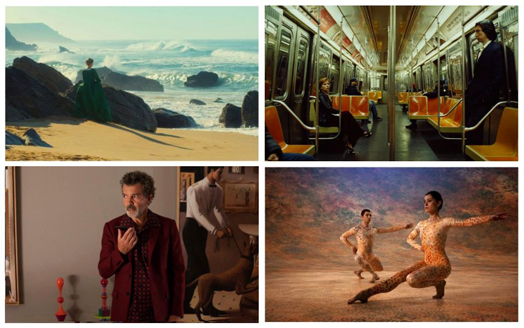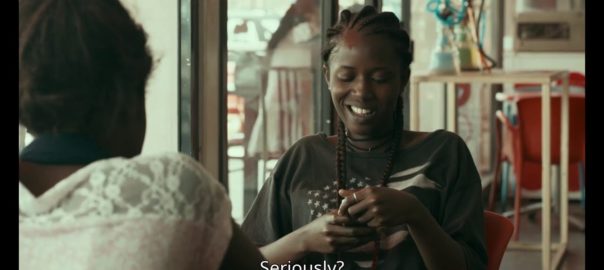
According to IndieWire’s Kate Erbland, Eric Kohn, Anne Thompson, Christian Blauvelt, David Ehrlich, Tambay Obenson, Jude Dry — superb and discerning film critics all — from buzzy awards players to unexpected gems, this year’s edition of the New York Film Festival is packed with thrilling choices. Today on VanRamblings, seven of those NYFF57 films that are also screening at the 38th annual Vancouver International Film Festival!
Atlantics
Most films that chronicle the plight of Africans undertaking the treacherous traversing of the Atlantic in search of better lives tend to be male-centric and grounded in stark realism. Mati Diop’s “Atlantics” upends that archetype, and harnesses fantasy and social relevance to tell a haunting story that focuses on the women who are often left behind. It’s one of the most original films of the year, and should continue to generate intrigue at both NYFF and VIFF en route to its Netflix launch.
Along the Atlantic coast, a soon-to-be-inaugurated futuristic tower looms over a suburb of Dakar, Senegal, but the construction workers haven’t been paid for months. Seventeen-year-old Ada (Mama Sané) is in love with Souleiman (Ibrahima Traoré), one of the construction workers, but has been promised to another man by her family. One night, the workers (including Souleiman) decide to leave the country by sea, in search of brighter futures. Whether they make it is a mystery.
Several days later, a fire ruins Ada’s wedding. Meanwhile, a mysterious fever starts to spread with incalculable ramifications. The strange, poetic circumstances keep piling up. “Atlantics” is a fantastical blend of romance and socio-political commentary at once, laced together by a surreal dreamscape.
But above all, this is a story about an impossible love, destroyed by injustice. Not since Diop’s own uncle, director Djibril Diop Mambety, made the seminal “Touki Bouki” has cinema seen an African couple worthy of the tragedy that is “Romeo and Juliet.” Diop made history when the film premiered at Cannes earlier this year — becoming the first black woman to direct a film featured in the festival’s Competition section. It won the Grand Prix, kicking off a festival run that will come to a head when it arrives at NYFF and VIFF with much-deserved hype. — TO
Cunningham
Legendary modern dance choreographer Pina Bausch presaged her American contemporary Merce Cunningham in a few non-dance-related areas: The lauded German artist passed away mere weeks before Cunningham did in 2009, and her work inspired a jaw-dropping 3D film eight years before Cunningham’s received the same sort of cinematic treatment. It’s hard to imagine a more fitting double feature than Wim Wenders’ “Pina” and Alla Kovgan’s upcoming “Cunningham,” a pair of 3D documentary features that bring to vivid life the work and artistry of two icons of modern dance through contemporary means.
Much like “Pina,” Kovgan’s film attempts to translate the magic of Cunningham’s live work (much of it crafted in New York City itself) to the big screen through 3D technology and an array of key archival material. Also like Bausch and the many devoted students she left behind, “Cunningham” grapples with the question of a choreographer’s legacy and what can actually remain of the kind of work that can be so literally fleeting. A choreographer is surely a creator, but when they make something as ephemeral as a dance — not a painting or a film or a sculpture, something that can be held — what becomes of their work? It’s a complicated question, and one that takes center stage in “Cunningham,” which helps unpack the choreographer’s own forward-thinking take on how to preserve his own legacy. — KE
Marriage Story
Netflix launched the “Marriage Story” bandwagon with raves at Venice and rolled into Telluride when Martin Scorsese presented his stunned “Silence” star Adam Driver with his tribute medallion. (The 35-year-old actor also showed “The Report” at both Telluride and Toronto.) But the role that will nab him his first Best Actor Oscar nomination (he scored a Supporting Actor nod this year for “BlacKkKlansman”) is Noah Baumbach’s wrenching (and painfully funny) divorce drama.
In fact, all three of its stars could land Oscar attention. Driver plays a New York stage director whose actress wife (never-nominated Scarlett Johansson) hires a hard-driving lawyer (fast-talking two-time Oscar nominee Laura Dern) in order to keep their young son in Los Angeles. NYFF and VIFF audiences will likely enjoy the push-and-pull between the two coasts; the film is both a look at the quieter reaches of LA and a distinctly New York valentine. When Driver is forced to take a crucial phone call in the middle of a busy street, Gothamites will sympathize.
While Baumbach gives both divorce parties plenty of attention, Driver gets to sing Stephen Sondheim at classic New York hangout Knickerbocker. Advantage Driver. — AT
Pain and Glory
Filmed in filmmaker Pedro Almodóvar’s real-life home and cast with longtime collaborators Antonio Banderas and Penélope Cruz, “Pain and Glory” has been touted as the closest thing to memoir we may ever see from the beloved Spanish auteur. Not only is Almodóvar one of the select few living filmmakers known only by their last name, that last name has become synonymous with a certain poetic intrigue, a colorful but emotionally-grounded aesthetic, and a joyous sensuality.
With his 21st feature film, the director turns the camera inward in what may be his most personal film to date. Banderas won the Best Actor award at this year’s Cannes Film Festival for his performance as Spanish director Salvador Mallo, whose crisp Jordans and color-blocked shirts make him a none-too-thinly-veiled ringer for the stylish Almodóvar. Preoccupied by the aches and pains of aging, memories of a love affair, and a fraught project, Salvador tries heroin on a whim.
Moving between time periods, “Pain and Glory” visits his ’60s-era childhood, with Cruz as the filmmaker’s mother, the heyday of the ’80s, and his mid-career conflicts in the present day. A return to form for the filmmaker who never truly left, “Pain and Glory” sees the master pushing himself to newer depths. NYFF played a key role in elevating Almodóvar’s U.S. profile, and this year, he repaid the favor by designing the festival’s poster. (He’ll also celebrate his birthday at the festival.) But his movie is the real star of this year’s show. NYFF and VIFF have always been firmly filmmaker-focused, and “Pain and Glory” offers a distinct and fresh take on what it means to be a true auteur. — JD
Parasite
For sheer storytelling bravura, it’s hard to top the armrest-gripping, breath-snatching suspense of “Parasite,” a thriller that also manages to be a blistering critique of trickle-down economics. This is one Palme d’Or winner that nobody will contest — a propulsive yarn more exciting than the most exciting action films released this year.
Except it’s not an action film: It’s a character study about a family of grifters who slowly worm their way into the life of an industrialist’s wife and her family. Are they feeding off their wealthy hosts like the title suggests? Is director Bong Joon Ho saying that crime is the natural outgrowth (and perhaps the only recourse for the marginalized) of capitalism? You decide. (But you probably won’t until well after the end credits have rolled because you’ll just be so caught up in finding out what happens next.)
“Hitchcockian” is one of the most over-used and inexpertly applied adjectives in film debates, but “Parasite” deserves the label not just because of its high-wire plot but its scathing dissection of class politics as set in a modernist house even the famously interior design-minded Master of Suspense would adore. (Seriously, this piece of real estate may even top the homes in “North by Northwest” and “Suspicion.”) Hitchcock famously said that his films were not a slice of life but a slice of cake. By the time the credits roll, Bong shows that even that kind of confection may not go down so easily. — CB
Portrait of a Lady on Fire
Céline Sciamma’s absolute barnburner of a romance may not be in the running for Best International Feature Film at the Oscars — France submitted Ladj Ly’s “Les Misérables” instead, despite the fact that nothing has a real shot of beating “Parasite — but “Portrait of a Lady on Fire” still has plenty of kindling to keep it lit. A profoundly tender story of self-discovery and creation that sparks when a reluctant 18th century bride-to-be (the brilliant Adèle Haenel) meets the beautiful woman who’s hired to paint her wedding portrait (the just-as-brilliant Noémie Merlant), this heart-stopping masterpiece not only won the Best Screenplay prize at Cannes this year, it was also named one of IndieWire’s 100 Best Films of the Decade; one accolade may be slightly more prestigious than the other, but it’s worth putting Sciamma’s accomplishment into proper context.
Austere where Sciamma’s “Tomboy” was anxious, and restrained where “Girlhood” was outgoing, “Portrait of a Lady on Fire” is a period romance that’s traditional in some ways, progressive in others, and altogether so damn powerful that it will leave you weak in the knees (especially after that all-timer of an ending). “Portrait” may not be able to ride the “Best International Feature” wave, but here’s hoping that its New York and Vancouver premières will help propel the film towards other forms of recognition. — DE
Vitalina Varela
The winner of the Golden Leopard from this year’s Locarno Film Festival is a perfect opportunity to discover the wonders of Pedro Costa. The Portuguese director conjures dark, dreamlike portraits of post-colonial neglect and yearning that hover somewhere between fantasy and neorealism, horror and melodrama, spirituality and desperation. Costa’s fifth journey into the shantytown Fontainhas, which lies on the outskirts of Lisbon, once again showcases Costa’s masterful ability to mine cinematic poetry from a unique environment and the mournful figures who wander its murky depths.
The Costa Expanded Universe stems back to 2006’s “Colossal Youth,” when he first began exploring the Cape Verdean residents of Fontainhas by casting members of the immigrant community as themselves. The ravishing blend of light and shadow captures the characters as they explore the claustrophobic interiors of their ramshackle homes and muse about their aimless lives. Costa’s dour, humorless aesthetic takes time to settle in and certainly requires a degree of openness to his approach, but “Vitalina Varela” is a perfect distillation of the rewarding nature of that process.
At its centre, the eponymous Vitalina steps up from her supporting role in Costa’s “Horse Money,” playing a version of herself as a woman who returns to the shantytown after her estranged husband has passed. As Vitalina roams the town and wrestles with the past, she hovers in a mesmerizing labyrinth of soul-searching and grief (she also befriends a despondent priest, Ventura, who oversees an abandoned house of prayer as if preaching from the end of times). “Vitalina Varela” feels at once otherworldly and familiar in its evocation of perseverance amid dire conditions; it’s a tragic lament with the slightest glimmer of hope. NYFF did the right thing by putting “Vitalena” in its main slate, rather than its experimental sidebar; this is the sort of singular creative vision that everyone who cares about movies should seek out. — EK
![]()
![]()
![]()
C’mon back tomorrow when VanRamblings will present in-depth insight and information on this year’s can’t miss Shorts programme, and an interview with VIFF’s longtime Shorts programmer, the ever-so-humane Sandy Gow.
In the meantime, click on the graphic below to access all of VanRamblings’ coverage to date of our 38th annual Vancouver International Film Festival.
 |
